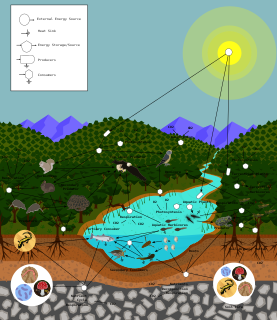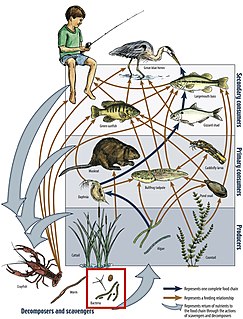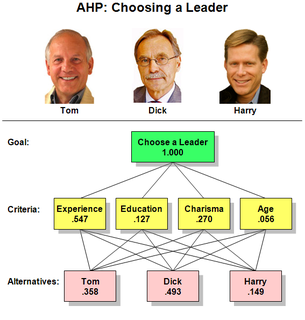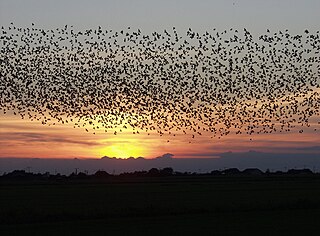Related Research Articles

Theoretical ecology is the scientific discipline devoted to the study of ecological systems using theoretical methods such as simple conceptual models, mathematical models, computational simulations, and advanced data analysis. Effective models improve understanding of the natural world by revealing how the dynamics of species populations are often based on fundamental biological conditions and processes. Further, the field aims to unify a diverse range of empirical observations by assuming that common, mechanistic processes generate observable phenomena across species and ecological environments. Based on biologically realistic assumptions, theoretical ecologists are able to uncover novel, non-intuitive insights about natural processes. Theoretical results are often verified by empirical and observational studies, revealing the power of theoretical methods in both predicting and understanding the noisy, diverse biological world.

Predation is a biological interaction where one organism, the predator, kills and eats another organism, its prey. It is one of a family of common feeding behaviours that includes parasitism and micropredation and parasitoidism. It is distinct from scavenging on dead prey, though many predators also scavenge; it overlaps with herbivory, as seed predators and destructive frugivores are predators.

A food web is the natural interconnection of food chains and a graphical representation of what-eats-what in an ecological community. Another name for food web is consumer-resource system. Ecologists can broadly lump all life forms into one of two categories called trophic levels: 1) the autotrophs, and 2) the heterotrophs. To maintain their bodies, grow, develop, and to reproduce, autotrophs produce organic matter from inorganic substances, including both minerals and gases such as carbon dioxide. These chemical reactions require energy, which mainly comes from the Sun and largely by photosynthesis, although a very small amount comes from bioelectrogenesis in wetlands, and mineral electron donors in hydrothermal vents and hot springs. These trophic levels are not binary, but form a gradient that includes complete autotrophs, which obtain their sole source of carbon from the atmosphere, mixotrophs, which are autotrophic organisms that partially obtain organic matter from sources other than the atmosphere, and complete heterotrophs that must feed to obtain organic matter.

Landscape ecology is the science of studying and improving relationships between ecological processes in the environment and particular ecosystems. This is done within a variety of landscape scales, development spatial patterns, and organizational levels of research and policy. Concisely, landscape ecology can be described as the science of "landscape diversity" as the synergetic result of biodiversity and geodiversity.
An energy carrier is a substance (fuel) or sometimes a phenomenon that contains energy that can be later converted to other forms such as mechanical work or heat or to operate chemical or physical processes.

In the theory of decision making, the analytic hierarchy process (AHP), also analytical hierarchy process, is a structured technique for organizing and analyzing complex decisions, based on mathematics and psychology. It was developed by Thomas L. Saaty in the 1970s; Saaty partnered with Ernest Forman to develop Expert Choice software in 1983, and AHP has been extensively studied and refined since then. It represents an accurate approach to quantifying the weights of decision criteria. Individual experts’ experiences are utilized to estimate the relative magnitudes of factors through pair-wise comparisons. Each of the respondents compares the relative importance each pair of items using a specially designed questionnaire.

A metapopulation consists of a group of spatially separated populations of the same species which interact at some level. The term metapopulation was coined by Richard Levins in 1969 to describe a model of population dynamics of insect pests in agricultural fields, but the idea has been most broadly applied to species in naturally or artificially fragmented habitats. In Levins' own words, it consists of "a population of populations".

Spatial analysis or spatial statistics includes any of the formal techniques which studies entities using their topological, geometric, or geographic properties. Spatial analysis includes a variety of techniques, many still in their early development, using different analytic approaches and applied in fields as diverse as astronomy, with its studies of the placement of galaxies in the cosmos, to chip fabrication engineering, with its use of "place and route" algorithms to build complex wiring structures. In a more restricted sense, spatial analysis is the technique applied to structures at the human scale, most notably in the analysis of geographic data or transcriptomics data.

Optimal foraging theory (OFT) is a behavioral ecology model that helps predict how an animal behaves when searching for food. Although obtaining food provides the animal with energy, searching for and capturing the food require both energy and time. To maximize fitness, an animal adopts a foraging strategy that provides the most benefit (energy) for the lowest cost, maximizing the net energy gained. OFT helps predict the best strategy that an animal can use to achieve this goal.

An ecosystem model is an abstract, usually mathematical, representation of an ecological system, which is studied to better understand the real system.

In ecology, a community is a group or association of populations of two or more different species occupying the same geographical area at the same time, also known as a biocoenosis, biotic community, biological community, ecological community, or life assemblage. The term community has a variety of uses. In its simplest form it refers to groups of organisms in a specific place or time, for example, "the fish community of Lake Ontario before industrialization".
Multiscale decision-making, also referred to as multiscale decision theory (MSDT), is an approach in operations research that combines game theory, multi-agent influence diagrams, in particular dependency graphs, and Markov decision processes to solve multiscale challenges in sociotechnical systems. MSDT considers interdependencies within and between the following scales: system level, time and information.
An integrative level, or level of organization, is a set of phenomena emerging from pre-existing phenomena of a lower level. The levels concept is an intellectual framework for structuring reality. It arranges all entities, structures, and processes in the universe, or in a certain field of study, into a hierarchy, typically based on how complex their organization is. When arranged this way, each entity is three things at the same time: It is made up of parts from the previous level below. It is a whole in its own right. And it is a part of the whole that is on the next level above. Typical examples include life emerging from non-living substances, and consciousness emerging from nervous systems.

Collective animal behavior is a form of social behavior involving the coordinated behavior of large groups of similar animals as well as emergent properties of these groups. This can include the costs and benefits of group membership, the transfer of information, decision-making process, locomotion and synchronization of the group. Studying the principles of collective animal behavior has relevance to human engineering problems through the philosophy of biomimetics. For instance, determining the rules by which an individual animal navigates relative to its neighbors in a group can lead to advances in the deployment and control of groups of swimming or flying micro-robots such as UAVs.
In decision-making, a rank reversal is a change in the rank ordering of the preferability of alternative possible decisions when, for example, the method of choosing changes or the set of other available alternatives changes. The issue of rank reversals lies at the heart of many debates in decision-making and multi-criteria decision-making, in particular.
A social-ecological system consists of 'a bio-geo-physical' unit and its associated social actors and institutions. Social-ecological systems are complex and adaptive and delimited by spatial or functional boundaries surrounding particular ecosystems and their context problems.

EcoSim is an individual-based predator-prey ecosystem simulation in which agents can evolve. It has been designed to investigate several broad ecological questions, as well as long-term evolutionary patterns and processes such as speciation and macroevolution. EcoSim has been designed by Robin Gras at the University of Windsor in 2009 and it is still currently used for research in his Bioinformatics and Ecosystem Simulation Lab.
Hierarchy theory is a means of studying ecological systems in which the relationship between all of the components is of great complexity. Hierarchy theory focuses on levels of organization and issues of scale, with a specific focus on the role of the observer in the definition of the system. Complexity in this context does not refer to an intrinsic property of the system but to the possibility of representing the systems in a plurality of non-equivalent ways depending on the pre-analytical choices of the observer. Instead of analyzing the whole structure, hierarchy theory refers to the analysis of hierarchical levels, and the interactions between them.
MuSIASEM or Multi-Scale Integrated Analysis of Societal and Ecosystem Metabolism, is a method of accounting used to analyse socio-ecosystems and to simulate possible patterns of development. It is based on maintaining coherence across scales and different dimensions of quantitative assessments generated using different metrics.
Quantitative storytelling (QST) is a systematic approach used to explore the multiplicity of frames potentially legitimate in a scientific study or controversy. QST assumes that in an interconnected society multiple frameworks and worldviews are legitimately upheld by different entities and social actors. QST looks critically on models used in evidence-based policy (EBP. Such models are often reductionist, in the sense discussed by, in that tractability is achieved at the expenses of suppressing relevant available evidence. QST suggests corrective approaches to this practice.
References
- ↑ Ahl, Valerie; Allen, Timothy F. H. (1996). Hierarchy theory: a vision, vocabulary, and epistemology. New York: Columbia University Press. ISBN 0231084803. OCLC 34149766.
- ↑ Giampietro, Mario; Allen, Timothy F. H.; Mayumi, Kozo (December 2006). "The epistemological predicament associated with purposive quantitative analysis". Ecological Complexity . 3 (4): 307–327. doi:10.1016/j.ecocom.2007.02.005.
- ↑ Kovacic, Zora; Giampietro, Mario (December 2015). "Empty promises or promising futures? The case of smart grids". Energy . 93 (Part 1): 67–74. doi:10.1016/j.energy.2015.08.116.
- ↑ Serrano-Tovar, Tarik; Giampietro, Mario (January 2014). "Multi-scale integrated analysis of rural Laos: studying metabolic patterns of land uses across different levels and scales". Land Use Policy. 36: 155–170. doi:10.1016/j.landusepol.2013.08.003.